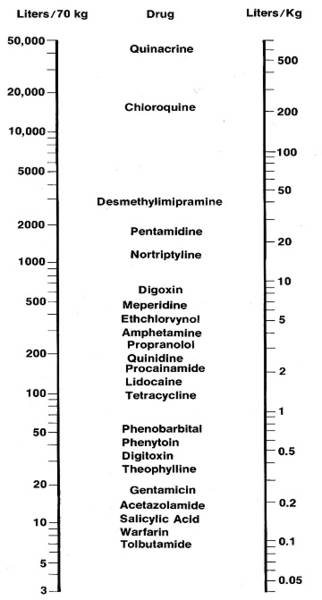

#Volume of distribution free
For a drug which is preferentially bound to plasma proteins, for equal free concentrations the total concentrations will be higher in plasma than in the extracellular space. However, most substances bind to plasma and tissue proteins. The apparent volumes of distribution of such drugs approximate their true volume of distribution. If a drug is likewise not bound in plasma and tissues, but does not penetrate cells, the distribution will be limited to the extracellular space, equalling 14 litres.

If a drug which is not bound in plasma or tissues, and distributes over total body water, the apparent volume of distribution will be 42 litres per 70 kg this is the case, for example, for antipyrine. Total body water (42 litres in a normal 70 kg man) consists of plasma (3 litres), interstitial fluid (11 litres) and intracellular fluid (28 litres). Drugs can have apparent volumes of distribution from 0.04 l kg −1 to 20l kg −1, i.e. It is therefore called ‘apparent’ volume of distribution. This calculated value does not correspond to an anatomical or physiological part of the organism and can be much larger than the volume of total body water. It is the volume in which the drug apparently distributes in a concentration equal to its concentration in plasma. The volume of distribution is a proportionality constant, relating the total amount of drug present in the organism to its plasma concentration at the same moment. Bogaert, in The Practice of Medicinal Chemistry (Second Edition), 2003 A Volume of distribution Drug molecules distribute slower to tissues that have lower perfusion, such as skeletal muscle, bone, and adipose tissue.įranz M. These tissues include brain, heart, lung, kidney, and liver. Thus, drug molecules distribute fastest to tissues that are highly perfused with blood (high blood flow). Increasing tissue binding and V d are related to increasing lipophilicity.ĭrug molecules are carried to the tissues by systemic circulation. It only indicates that f b,tissue (bound drug fraction in tissue) is high. However, high V d does not produce a high-unbound therapeutic target exposure. In the past, there was a tendency to interpret high V d as high tissue exposure. If f u,plasma and f u,tissue are similar, then V d is the sum of V plasma and V tissue. If a drug is highly bound in tissue, f u,tissue is low and V tissue predominates. If a drug is highly bound in plasma proteins, f u,plasma is low and V plasma predominates. This relationship explains the categories of drugs described above. Where V plasma is plasma volume, V tissue is tissue volume, f u,plasma is fraction of unbound drug in plasma, and f u,tissue is the fraction of unbound drug in tissue. V d = V plasma + V tissue ⋅ f u, plasma / f u, tissue , In this case, V d exceeds body water volume (0.7 L/kg) and may reach high levels (e.g., 5-100 L/kg or greater). These drugs tend to be highly lipophilic. High V d drugs are highly permeable into cells and highly bound to tissue components versus plasma proteins. V d is in the range of the volume of total body water or higher (0.6-5 L/kg). They tend to distribute evenly throughout the blood and tissues. Moderate V d drugs are moderately lipophilic, so they permeate into cells, and are moderately bound to plasma protein and tissue components.

#Volume of distribution plus
In this case, V d is in the range of the volume of blood plus extracellular fluid (typically 0.1-0.4 L/kg). (A large portion of body volume is the intracellular volume.) Acids, which bind to plasma proteins and have limited permeability into cells, are examples of low V d drugs. They are restricted to the bloodstream and extracellular fluid and do not enter the tissue cells in significant amounts. Low V d drugs are either highly bound to plasma proteins versus tissue components, or not lipophilic enough to bind to tissues. V d is dependent on the drug’s physicochemical properties:


 0 kommentar(er)
0 kommentar(er)
